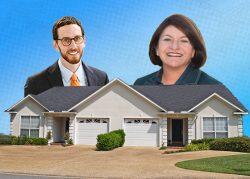The movement to ban single-family zoning has come to New York.
State Sen. Brad Hoylman introduced a bill this week that would allow multifamily construction on almost all residential lots, eliminate parking requirements in cities and villages, and stop larger localities from requiring large lot sizes for homes.
The legislation would prohibit cities and villages from setting minimum lot sizes larger than 1,200 square feet. It would also bar them from requiring off-street parking.
In cities, landowners could build four-family dwellings on any residential lot, or up to six-family buildings within a quarter mile of a train station. In villages, builders could construct duplexes on any residential lot or six-family dwellings near transit stations.
The bill also addresses towns, setting a maximum lot size of 20,000 square feet, or 5,000 square feet if the parcel has access to sewer or water infrastructure.
“We need to end the policy of exclusionary zoning that disadvantages lower- and middle-income New Yorkers,” said Hoylman. “The affordability crisis is best addressed statewide.”
rnrn“It starts the conversation, and it starts it with a bang.”rnrn
The Manhattan Democrat cited a study by the Furman Center which found that New York has some of the most exclusionary zoning in the country, particularly in the suburban enclaves of Westchester and Long Island.
“The results of these policies are clear: a state with fewer homes, higher rents, higher levels of segregation, higher carbon emissions, and a slower economy,” wrote Hoylman.
Noah Kazis, a legal fellow at the Furman Center and the author of the report, says the paper was meant to encourage New York politicians to take the problem of exclusionary zoning as seriously as some counterparts in similar states have.
“I’m really heartened to see this legislation come out because it starts that conversation, and it starts it with a bang,” Kazis said.
In New York, as in nearly every state, the state government leaves zoning to localities. But Connecticut, Massachusetts and California have passed laws to spur increased density in suburbs in recent years.
In California, where nearly two-thirds of all homes are single-family dwellings, lawmakers recently allowed owners of single-family lots to build up to four units on them. The state also passed a bill encouraging higher density near transit hubs.
Read more


If Hoylman’s bill gains any traction in Albany, it would face withering pushback from suburban, exurban and rural areas, where apartment projects in single-family areas are usually opposed by local residents.
In the early 1970s, the last time New York tried to integrate its suburbs through zoning reform, the bureaucrat running the program received death threats. Gov. Nelson Rockefeller’s plan was eventually repealed. And, while rezoning can draw bipartisan support, it opponents also tend to come from both sides of the aisle, united by a common desire to prevent change.
Hoylman himself objected to the Soho/Noho upzoning, which was approved this week. Last year he called the plan “the Amy Coney Barrett of rezoning proposals” because it would be decided in the final months of the de Blasio administration. He also said it would allow large buildings that would change the character of the area, which is exactly what critics of his statewide bill will say if it ever gets to a hearing.
But urban planners and advocates of affordable housing are huge fans of allowing multiple dwellings on what are now single-family lots. “These common-sense reforms are incredibly popular,” Hoylman said. “My office inbox is full of New Yorkers thanking me for introducing this bill.”
